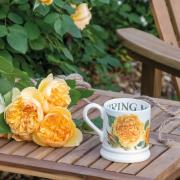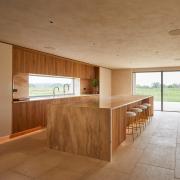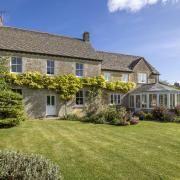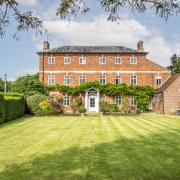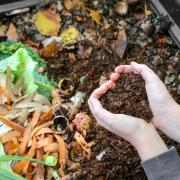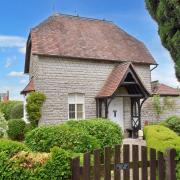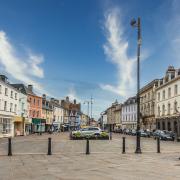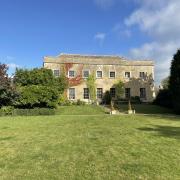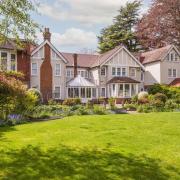Sometimes, the most important thing you can do in a garden is to take something out. At Cotswold Farm, while there has been plenty of replanting since my last visit, it’s the removal of a large parrotia that’s had the greatest impact.
Part of a line of trees in the Shrub Garden along with a cornus and large magnolia, it was blocking the view from the upper terrace of an ornate gate and the orchard beyond.
‘It was something we did quite early on,’ says Sarah Birchall. ‘It was quite scary.’
The result though was worth the leap of faith with the long vista from terrace to countryside now restored.

‘I think the view is a major selling point for this garden,’ comments Sarah, and it is memorable with the Cotswold countryside acting as a borrowed addition to the garden.
Sarah and her husband, John, took on Cotswold Farm in 2020 from John’s mother, Iona, who had cared for it for the previous 20 years.
An Arts and Crafts garden set on the side of a valley at Duntisbourne Abbots, it has a series of terraces that were designed and laid out by Norman Jewson in the 1930s with beautiful Cotswold stone walls and yew hedges.

As with any mature garden, their first few years have been a mix of removal, replanting and editing what was already there, working with their two part-time gardeners.
‘When we first came here, it did feel a huge responsibility,’ says Sarah. ‘We realised quite quickly that it wasn’t just maintaining the garden. There were quite a lot of things that needed doing to refresh it. So, it was daunting but it was also a wonderful opportunity.’
Previously they’d spent 20 years in London with John working as a Church of England minister and they honed their gardening skills in a series of vicarage plots.

‘We were fortunate that each of the vicarages we lived in had a garden, and that’s how we started learning about it.’
Studying for an RHS diploma also gave Sarah more confidence to take on the historic garden – ‘That was an amazing thing to have done before coming here because although I didn’t suddenly become an expert, it meant I had more of an idea of how things worked.’
The main terrace is a series of intricate, geometric beds laid out either side of a formal lily pond – now cleared of weed and an island of sedge.

The couple are conscious of the need to make sure the design isn’t overshadowed by planting and earlier this year revamped the whole area. What were blocks of perennials have now been replaced with a repeating pattern of roses, dahlias, geraniums and verbenas all edged with teucrium. At the heart of each bed is a Phillyrea latifolia, which is going to be shaped as a single stem feature.
“It’s been a bold move and is in its early stages of development but shows great promise,” says John.
What makes tackling any of the beds tricky is the garden’s snowdrop collection, started in the 1930s. Developed by John’s step-grandmother Ruth Birchall in the 1980s and 90s, it now has around 80 different varieties with many in the terrace and shrub gardens. Although clumps are labelled, any digging has to be done carefully.

Meanwhile, a long bed to one side has been cleared, allowed to lie fallow to tackle persistent weeds and now replanted with shrubs and perennials, including salvias, violas and achilleas, chosen so they don’t screen the Cotswold stone wall behind.
These walls, along with topiarised yew and box, give the garden the characteristic Arts and Crafts structure against which the planting is laid.
In late summer, the white border on the upper terrace is still in full flower with dahlias, Centranthus ruber ‘Albus’, and fuchsia that have taken over from roses, hollyhocks and buddleia.

The long expanse of paving is softened by planting pockets filled with helianthemums, while the edge of the retaining wall is screened with clipped yew.
On the other side of the house, the top of one of the retaining walls is home to an alpine bed that is gradually being renovated while a small three-sided courtyard against the house is full of late summer colour with Japanese anemones, dahlias and phlox.
A more relaxed style is evident in the Shrub Garden where shrubs – kolkwitzia, winter honeysuckle and yellow Buddleja x weyeriana – are mixed with trees, including the Cercis silaquastrum and spindle. There is a long border of delphiniums edged with Alchemilla mollis, more dahlias, hylotelephium (formerly sedum) and roses that are being trained as domes to encourage more flowers with the relocated brunnera at their feet.

Another section of roses that were judged ‘not nice’ along the lower wall are slowly being dug out along with acanthus that has spread and an assortment of weeds.
A battle of a different kind is being fought in the topiary garden where ancient box is fashioned into gargoyle-like ‘faces’. So far, the couple are winning against the ravages of box moth caterpillar.
Below the shrub garden, wire fencing has been removed in the orchard, now planted with fruit trees and wildflowers with mown paths through.

It’s the Bog Garden at the lower end of the garden that is an area that’s likely to see the biggest overhaul. Already, evergreens, an acer, ash and willows that were either dead, misshapen or simply too big have been removed and there’s an ongoing discussion about what their replacements should be.
‘It had lots of character and is a very special part of the garden but it needed a fresh plan,’ says John, who’s taken on this project. ‘So, we’ve bitten the bullet and taken those out. Now we need to reshape and redesign.’
There’s been some tweaking of the Steps Garden, which was planted to provide mainly winter interest with red dogwoods, mahonia and daphne. A membrane originally added to deter weeds has been removed, allowing the soil to breathe, and Sarah is starting to tame overgrown shrubs such as Garrya elliptica and Viburnum davidii. The couple have been helped with the sometimes drastic pruning by one of a trio of horticultural experts who visit to offer advice.

And they are growing in confidence the more they do: ‘We’ve moved from being quite overwhelmed by it to being actually able to enjoy, understand, and love each part of it,’ says John.
It’s a love they hope to pass on to visitors: ‘It is hard work but we want people to come here and be refreshed,’ says Sarah. ‘That’s our motivation. It’s not just preserving an historic place.’
Cotswold Farm Gardens are open for the National Garden Scheme on August 31, and September 1. More information on the website: www.cotswoldfarmgardens.org.uk





